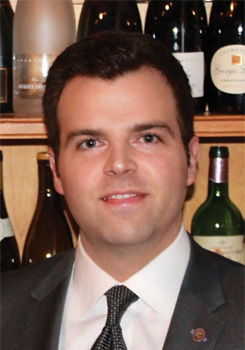Two years ago, Justin Timsit was working in the fashion industry in LA and collecting wine, when he discovered the Court of Master Sommeliers. After he passed the first two levels and found that he enjoyed studying wine, he started managing the wine program at Tagine, a small Moroccan restaurant in Beverly Hills. Timsit was commuting east to visit his girlfriend in New Jersey when he spotted an ad for a wine director at The Rittenhouse Hotel in Philadelphia. He’s been there for a year now, learning the ropes of Pennsylvania wine law and working on convincing guests to treat Champagne as they would any other great wine.


On cerebral Champagne
We talk a lot about it as a wine, not just a celebratory type of beverage. And I think people are taking it more seriously. There’s a lot more knowledge about it—people are more aware of newer producers in that terroir-expressive style. Part of it comes from us serving it in a wine glass; I’ve eliminated the flute almost entirely. After they’ve tasted, say, Pierre Peters in a wine glass, and I bring a flute to table and pour it right next to the wine glass, they understand how it’s a wine to be taken seriously, like a Burgundy.
To me, it’s the most cerebral, pleasurable wine in the world. There is terroir in Champagne, especially if you get into the details, find out about the traditions, the winemaking procedures, Champagne is just amazing. Look at Selosse—he could make as much as he wants and call it Grand Cru from Avize, but he chose to restrict yields and make a limited amount.
We had only one or two growers on the list when I came on board; all we sold was Veuve Clicquot. Now we have 35 or 40. Bereche has taken the spotlight from Veuve Clicquot; it’s probably one of most exciting things to happen for me personally in our restaurant. I priced it lower than Veuve, so if people wanted something really good, really high quality, they could reach for that. The tricky part for us is the state control; there’s very limited access and pricing is basically retail; we pay the same price plus more. So it’s difficult to structure a list. You really have to find things that people can’t find in stores, smaller producers you might have to special order.
On riesling’s expansion
This is one of the parts of the list I expanded just as much as grower Champagne. We had a couple of off-dry Mosel and Alsace rieslings, no Austrian, and one or two from the US. Now I’m making a big push to introduce guests to dry riesling. Many people still have this idea that it’s not dry and so it’s not serious. So whenever there’s an opportunity to introduce it, I do—and there are a lot, as it is so compatible with our food. Our chef’s food is delicate yet rustic at the same time, and it tends to lend itself to white wine—so much so it can be a problem. We just had a meeting because we had this wine pairings menu, and out of all the wines, ten were white and only two were red; we had to go back and rebalance to see if we could get in more red wines, because we know there will be people who are going to be asking, where’s the red wine?
On sauvignon blanc and other “Wines of Note”
Sauvignon blanc is great for us. Sancerre sells itself. The Crochet [#2 on his Top Ten] is an entry-level wine—affordable, great. But then we also have a Vatan at $200; that’s amazing wine. What’s been fun, though, is to use the popularity of Sancerre to introduce people to wines like Quincy, Reuilly—wines that give the same pleasure as Sancerre without the price tag. The way we have the wine list organized, we have wines from major villages grouped together; then have section in each major grape called “Wines of Note.” Those are usually from satellite or lesser-known areas, and because they are grouped with the better-known place, that draws attention.
What would you have for dinner tonight?
We have a pretty amazing lobster dish on the menu right now: It’s a salad of poached lobster, served with fresh papaya and avocado and lacto-fermented red beets in a brown butter sauce; topped with little bit of royal imperial osetra caviar. I’d have that with the Selosse Substance Grand Cru Blanc de Blanc Avize—it’s a non-vintage wine from a solera started in 1986. It has so much richness and layers and layers of complexity from so many years of blending. We actually pair the dish with the Chartogne Taillet—he was an apprentice of Selosse, so it’s in a very similar oxidative style. It works so well with the saltiness of the caviar, the fruity flavors of the papaya; the textures of the lobster and avocado with the thick, rich mousse of the Champagne, plus that touch of oxidative nuttiness with the brown butter.
is W&S’s editor at large and covers the wines of the Mediterranean and Central and Eastern Europe for the magazine.
















